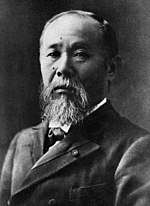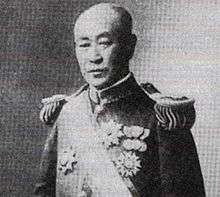Chōshū Five
The Chōshū Five (長州五傑, Chōshū Goketsu) were members of the Chōshū han of western Japan who travelled to England in 1863 to study at University College London[1]. The five students were the first of many successive groups of Japanese students who travelled overseas in the late Bakumatsu and early Meiji eras. All five students later rose to prominent positions in Japanese political and civil life.
.jpg)
Background and participants
The Chōshū han, based what is now known as Yamaguchi Prefecture, was eager to acquire better knowledge of the western nations and gain access to military technology in order to strengthen the domain in its struggle to overthrow the Tokugawa shogunate. The decision by Chōshū han elders to sponsor five promising students to study overseas came in the midst of growing domestic political tensions and in the wake of reports from the First Japanese Embassy to Europe that had returned in January 1863.
At the time of the students’ departure it was still illegal to leave Japan and travel overseas due to the shogunate's maritime seclusion policy (sakoku or, as it was known at the time, kaikin). This policy was only finally abolished in 1866.
| Name | Image | Note |
|---|---|---|
| Itō Shunsuke 伊藤 博文 (1841 - 1909) |
 |
Later named Itō Hirobumi. First Prime Minister of Japan |
| Inoue Monta 井上 馨 (1836 - 1915) |
 |
Later named Inoue Kaoru. Minister of Foreign Affairs |
| Yamao Yōzō 山尾 庸三 (1837 - 1917) |
 |
Studied engineering at the Andersonian Institute in Glasgow from 1866 to 1868 while working at the River Clyde based Napier shipyards by day. |
| Endō Kinsuke 遠藤 謹助 (1836 - 1893) |
 |
Later served as the head of the National Mint in Osaka |
| Nomura Yakichi 井上 勝 (1843 - 1910) |
 |
Later named Inoue Masaru. Known as the 'Father of Japanese Railways'. |
Voyage to Britain
With the support of Kyushu based trader Thomas Blake Glover, arrangements were made through his local agent, a Mr. Weigal, to secure passage for the five students on one of the many British trading ships calling at the port of Yokohama. The Chōshū students disguised as English sailors were put aboard the Jardine, Matheson & Co. vessel Chelswick for 1000 ryō each with the reluctant agreement of the ship's captain, J. S. Gower. The five departed Yokohama on the 27 June 1863, bound for Shanghai where they were sheltered on an opium storage ship before dividing into two groups for the extended voyage around the Cape of Good Hope to London.
While Inoue Masaru, Yamao Yōzō and Endō Kinsuke travelled to Europe as passengers on the 915 ton three-masted tea clipper Whiteadder, Inoue Kaoru and Itō Hirobumi, destined to be two of the greatest Japanese statesmen of the age, were mistakenly assumed to be eager to earn their passage as crew and were put to work as deckhands on a grueling 130 day journey aboard the 525 ton sailing ship Pegasus[2].
Studies in Britain
Pegasus reached London on 4 November 1863, Whiteadder arriving three days later on the 7th. The reunited Chōshū students were introduced by Hugh Matheson, senior partner of Matheson and Company to Dr. Alexander Williamson, FRS, Professor of Chemistry at University College, London. Itō Hirobumi, Endō Kinsuke and Inoue Masaru lodged at the Camden home of Professor Williamson and his family, while Inoue Kaoru and Yamao Yōzō lodged in Gower Street adjacent to the university campus.
Inoue Kaoru and Itō Hirobumi returned after only six months in early April 1864 when they received news via Jardine Matheson's London representatives that the Chōshū clan was engaged in direct conflict with Western allied powers over control of the strategic Straits of Shimonoseki. Endo also returned in the later half of 1866 for health reasons. Yamao Yōzō and Inoue Masaru eventually returned to Japan in 1868.
150th anniversary celebrations
2013 was the 150th anniversary of the Chōshū Five departing Japan to commence studies at University College London (UCL). There were several commemorative events held in both Japan and the United Kingdom to mark this event. In July, there was a celebration hosted by UCL at the main campus with participation from representatives of the Japan embassy in London.
Visit 150 years later by Japan's Prime Minister
On 1st May 2014 Japan's Prime Minister Shinzō Abe paid a courtesy visit to UCL and the monument of the Chōshū Five therein[3].
External links
- Nagasaki in the Meiji Restoration - links Thomas Glover and the Chōshū Five
References
- Prime Minister visited the monument of Chōshū Five in UCL
- "Pegasus". Aberdeen Built Ships. Aberdeen Maritime Museum. Retrieved 26 May 2017.
- Japan's Prime Minister Shinzo Abe has thanked UCL for its role in helping to educate students from his country dating back 150 years to the Chōshū Five in the 19th century.